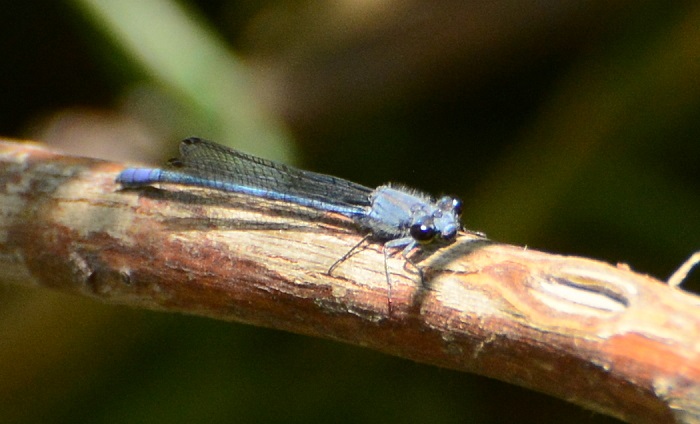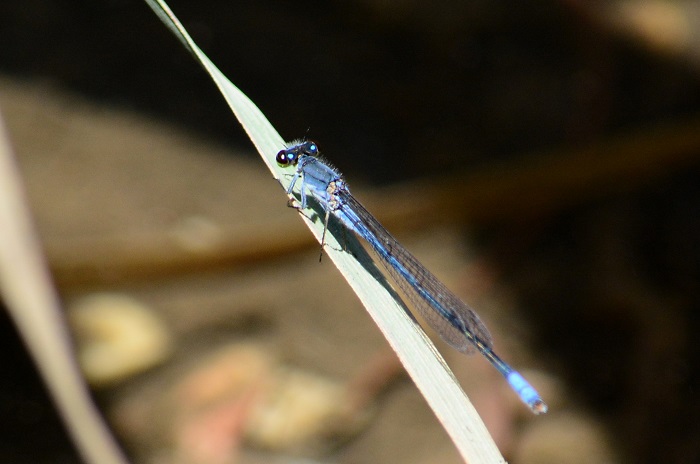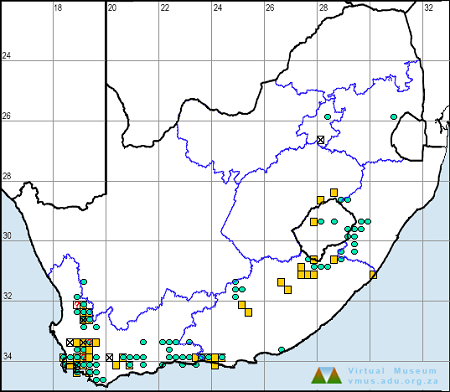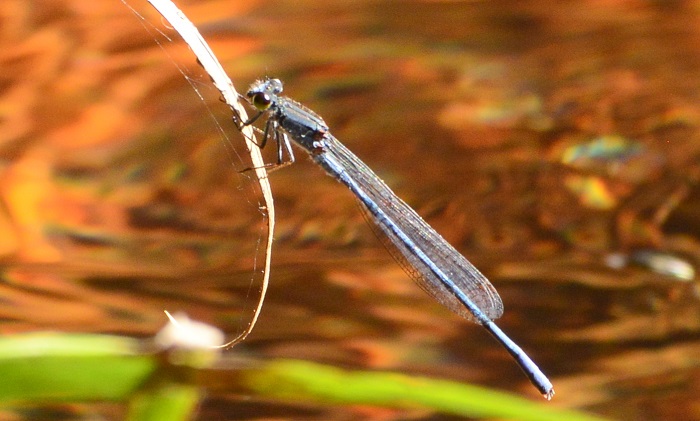Cover photo by Corrie du Toit.
Find the Mountain Sprite in the FBIS database (Freshwater Biodiversity Information System) here.
Family Coenagrionidae
Identification

Seweweekspoort, Western Cape
Photo by Ryan Tippett
Small size
Length up to 37mm; Wingspan reaches 47mm.
Populations of the Mountain Sprite in the southern parts of the Western Cape have very reduced or absent postocular spots. These spots are quite large, round, and bright blue over the rest of its range.
The Mountain Sprite is most similar to Pseudagrion salisburyense (Slate Sprite) and Pseudagrion spernatum (Upland Sprite).
The Mountain Sprite is differentiated from S. salisburyense by having a pruinose white forehead and a lightly pruinose, dark blue abdomen. Told apart from P. spernatum by having a black rather than green labrum. In addition the species all have differently shaped claspers.
Females are variably coloured from yellowish to green with darker humeral stripes. They are best identified by their association with the males.
Click here for more details on identification.
Habitat
The Mountain Sprite inhabits streams and rivers in mountainous regions. It frequents sites with running water, large rocks, and tall fringing grass, reeds, and bushes.
The Mountain Sprite occurs at lower altitudes in the Western Cape but has been recorded up to 2100m above sea level in the Drakensberg, KwaZulu-Natal.

Photo by Ryan Tippett

Photo by Sharon Stanton
Behaviour
The Mountain Sprite perches on vegetation or rocks close to the water. It flies low between emergent and overhanging grass and sedge stems. Males and females are frequently found side by side.
Mountain Sprites are most active from October to April (see Phenology below).

Grootrivier, Cedarberg, Western Cape
Photo by Ryan Tippett
Status and Conservation
The Mountain Sprite is locally common across its range. It is listed as of Least Concern in the IUCN Red List of Threatened Species.
Distribution
The Mountain Sprite is endemic to South Africa, where it is mainly found in the southern and central mountainous regions. It ranges from the Cedarberg in the Western Cape to the Drakensberg regions of the Eastern Cape, KwaZulu-Natal, Free State, and Lesotho. There are also a few records from southern Gauteng

Seweweekspoort, Western Cape
Photo by Ryan Tippett
Below is a map showing the distribution of records for Mountain Sprite in the OdonataMAP database as at February 2020.

Below is a map showing the distribution of records for Mountain Sprite in the OdonataMAP database as of December 2024.

The next map below is an imputed map, produced by an interpolation algorithm, which attempts to generate a full distribution map from the partial information in the map above. This map will be improved by the submission of records to the OdonataMAP section of the Virtual Museum.


Ultimately, we will produce a series of maps for all the odonata species in the region. The current algorithm is a new algorithm. The objective is mainly to produce “smoothed” maps that could go into a field guide for odonata. This basic version of the algorithm (as mapped above) does not make use of “explanatory variables” (e.g. altitude, terrain roughness, presence of freshwater — we will be producing maps that take these variables into account soon). Currently, it only makes use of the OdonataMAP records for the species being mapped, as well as all the other records of all other species. The basic maps are “optimistic” and will generally show ranges to be larger than what they probably are.
These maps use the data in the OdonataMAP section of the Virtual Museum, and also the database assembled by the previous JRS funded project, which was led by Professor Michael Samways and Dr KD Dijkstra.
Phenology



Vanrhynsdorp Waterfall, Western Cape
Photo by Ryan Tippett
Further Resources
The use of photographs by Corrie du Toit and Sharon Stanton is acknowledged. All other photographs by Ryan Tippett.
Mountain Sprite Pseudagrion draconis Barnard, 1937
Other common names: Berggesie (Afrikaans)
Recommended citation format: Loftie-Eaton M; Navarro R; Tippett RM; Underhill L. 2025. Mountain Sprite Pseudagrion draconis. Biodiversity and Development Institute. Available online at https://thebdi.org/2020/05/15/mountain-sprite-pseudagrion-draconis/
References: Tarboton, M; Tarboton, W. (2019). A Guide to the Dragonflies & Damselflies of South Africa. Struik Nature.
Samways, MJ. (2008). Dragonflies and Damselflies of South Africa. Pensoft
Samways, MJ. (2016). Manual of Freshwater Assessment for South Africa: Dragonfly Biotic Index. Suricata 2. South African National Biodiversity Institute, Pretoria

